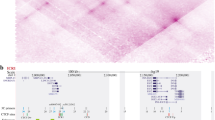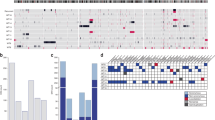Abstract
p57KIP2 is a potent tight-binding inhibitor of several G1 cyclin/Cdk complexes, and is a negative regulator of cell proliferation1,2. The gene encoding p57KIP2 is located at 11p15.5 (ref. 2), a region implicated in both sporadic cancers and Beckwith-Wiedemann syndrome, a cancer-predisposing syndrome, making it a tumour-suppressor candidate. Several types of childhood tumours including Wilms' tumour, adrenocortical carcinoma and rhabdomyosarcoma exhibit a specific loss of maternal 11p15 alleles, suggesting that genomic imprinting3–8 is involved9–12. Genetic analysis of the Beckwith-Wiedemann syndrome indicated maternal carriers, as well as suggesting a role of genomic imprinting13. Previously, we and others demonstrated that p57KIP2 is imprinted and that only the maternal allele is expressed in both mice and humans14–16. Here we describe p57KIP2 mutations in patients with Beckwith-Wiedemann syndrome. Among nine patients we examined, two were heterozygous for different mutations in this gene — a missense mutation in the Cdk inhibitory domain resulting in loss of most of the protein, and a frameshift resulting in disruption of the QT domain. The missense mutation was transmitted from the patient's carrier mother, indicating that the expressed maternal allele was mutant and that the repressed paternal allele was normal. Consequently, little or no active p57KIP2 should exist and this probably causes the overgrowth in this BWS patient.
This is a preview of subscription content, access via your institution
Access options
Subscribe to this journal
Receive 12 print issues and online access
$209.00 per year
only $17.42 per issue
Buy this article
- Purchase on Springer Link
- Instant access to full article PDF
Prices may be subject to local taxes which are calculated during checkout
Similar content being viewed by others
References
Mong-Hong, L., Reynisdottir, I. & Massgue, J. Cloning of p57KIP2, a cyclin-dependent kinase inhibitor with unique domain structure and tissue distribution. Genes Dev. 9, 639–649 (1995).
Matsuoka, S. et al. p57KIP2, a structurally distinct member of the p21CIP1 Cdk inhibitor family, is a candidate tumor suppressor gene. Genes Dev. 9, 650–662 (1995).
Softer, D. Differential imprinting and expression of maternal and paternal genomes. Annu. Rev. Genet. 22, 127–146 (1988).
Barlow, D.P. Imprinting: a gamete's point of view. Trends Genet. 10, 194–199. (1994).
Ohlsson, R., Barlow, D.P. & Surani, A. Impression of imprints. Trends Genet. 10, 415–417 (1994).
Razin, A. & Cedar, H. DNA methylation and genomic imprinting. Cell 77, 473–476 (1994).
Efstratiadis, A. Parental imprinting of autosomal mammalian genes. Curr. Opin. Genet. Dev. 4, 265–280 (1994).
Nicholls, R.D. New insights reveal complex mechanisms involved in genomic imprinting. Am. J. Hum. Genet. 54, 733–740 (1994).
Schroeder, W.T. et al. Nonrandom loss of maternal chromosome 11 alleles in Wilms tumors. Am. J. Hum. Genet. 40, 413–420 (1987).
Pal, N. et al. Preferential loss of maternal alleles in sporadic Wilms' tumour. Oncogene. 5, 1666–1668 (1990).
Scrable, H. et al. model for embryonal rhabdomyosarcoma tumorigenesis that involves genome imprinting. Proc. Natl. Acad. Sci. USA 86, 7480–7484 (1989).
Seizinger, B. et al. V. Report of the committee on chromosome and gene loss in human neoplasia. Cytogenet. Cell. Genet. 58, 1080–1096 (1991).
Lubinsky, M., Herrmann, J., Kosseff, A.L. & Opitz, J.M. Autosomal-dominant sex-dependent transmission of the Wiedemann-Beckwith syndrome. Lancet 1, 932 (1974).
Hatada, I. & Mukai, T. Genomic imprinting of p57KIP2, a cyclin-dependent kinase inhibitor, in mouse. Nature Genet. 11, 204–206 (1995).
Hatada, I. et at. Genomic imprinting of human p57KIP2 and its reduced expression in Wilms' tumors. Hum. Mol. Genet. 5, 783–788 (1996).
Matsuoka, S. et al. Imprinting of the gene encoding a human cyclin-dependent kinase inhibitor, p57KIP2, on chromosome 11p15. Proc. Natl. Acad. Sci. USA 93, 3026–3030 (1996).
Wiedemann, H.R. Tumours and hemihypertrophy associated with Wiedemann-Beckwith syndrome. Eur. J. Pediatr. 141, 129 (1983).
Waziri, M., Patil, S.R., Hanson, J.W. & Batrley, J. A Abnormality of chromosome 11 in patients with features of Beckwith-Wiedemann syndrome. J. Pediat 102, 873–876. (1983).
Okano, Y. et al. An infant with Beckwith-Wiedemann syndrome and chromosomal duplication 11p13–pter: correlation of symptoms between 11p trisomy and Beckwith-Wiedemann syndrome. Jap. J. Hum. Genet. 31, 365–372 (1986).
Pueschel, S.M. & Padre-Mendoza, T. Chromosome 11 and Beckwith-Wiedemann syndrome. J. Pediat. 104, 484–485 (1984).
Niikawa, N. et al. The Wiedemann-Beckwith syndrome: Pedigree studies on five families: evidence for autosomal dominant inheritance with variable expressivity. Am. J. Med. Genet. 24, 41–15 (1986).
Moutou, C., Junien, C., Henry, I. & Bonaiti-pellie, C. Beckwith-Wiedemann syndrome: A demonstration of the mechanisms responsible for the excess of transmitting females. J. Med. Genet. 29, 217–220 (1992).
Best, L.G. & Hoekstra, R.E. Wiedemann-Beckwith syndrome: autosomal dominant inheritance in a family. Am. J. Hum. Genet. 9, 291–299 (1981).
Henry, I. et al. Uniparental paternal disomy in a genetic cancer-predisposing syndrome. Nature 351, 665–667 (1991).
Ping, A.J. et al. Genetic linkage of Beckwith-Wiedemann syndrome to 11p15. Am. J. Hum. Genet. 44, 720–723 (1989).
Koufos, A. et al. Familial Wiedemann-Beckwith syndrome and a second Wilms tumour locus both map to 11p15.5. Am. J. Hum. Genet. 44, 711–719 (1989).
Koi, M. et al. Tumor cell growth arrest caused by subchromosomal transferable DNA fragments from chromosome 11. Science 260, 361–364 (1993).
Hoovers, J.M.N. et al. Multiple genetic loci within 11p15 defined by Beckwith-Wiedemann syndrome rearrangement breakpoints and subchromosomai transferable fragments. Proc. Natl. Acad. Sci. USA 92, 12456–12460 (1995).
Harper, J.W., Adami, G.R., Wei, N., Keyomarsi, K. & Elledge, S.J. The p21 Cdk-interacting protein Cip1 is a potent inhibitor of G1 cyclin-dependent kinases. Cell 75, 805–816 (1993).
Toyoshima, H. & Hunter, T. p27, a novel inhibitor of G1 cyclin-Cdk protein kinase activity, is related to p21. Cell 78, 67–74 (1994).
Polyak, K. et al. Cloning of p27 (Kip1), a cyclin-dependent kinase inhibitor and a potential mediator of extracellular antimitogenic signals. Cell 78, 59–66 (1994).
Kiyokawa, H. et al. Enhanced growth of mice lacking the cyclin-dependent kinase inhibitor function of p27KIP1. Cell 85, 721–732 (1996).
Fero, M.L.A. et al. Syndrome of multiorgan hyperplasia with features of gigantism, tumorigenesis, and female sterility in p27KIP1-deficient mice. Cell 85, 733–744 (1996).
Nakayama, K. et al. Mice lacking p27KIP1 display increased body size, multiple organ hyperplasia, retinal dysplasia, and pituitary tumors. Cell 85, 707–720 (1996).
Author information
Authors and Affiliations
Corresponding author
Rights and permissions
About this article
Cite this article
Hatada, I., Ohashi, H., Fukushima, Y. et al. An imprinted gene p57KIP2 is mutated in Beckwith–Wiedemann syndrome. Nat Genet 14, 171–173 (1996). https://doi.org/10.1038/ng1096-171
Received:
Accepted:
Issue Date:
DOI: https://doi.org/10.1038/ng1096-171
This article is cited by
-
Ongoing Challenges in the Diagnosis of 11p15.5-Associated Imprinting Disorders
Molecular Diagnosis & Therapy (2022)
-
Heterozygous rare genetic variants in non-syndromic early-onset obesity
International Journal of Obesity (2020)
-
The CDK inhibitor p57Kip2 enhances the activity of the transcriptional coactivator FHL2
Scientific Reports (2020)
-
Role of the imprinted allele of the Cdkn1c gene in mouse neocortical development
Scientific Reports (2020)
-
Clinical and molecular diagnosis, screening and management of Beckwith–Wiedemann syndrome: an international consensus statement
Nature Reviews Endocrinology (2018)



